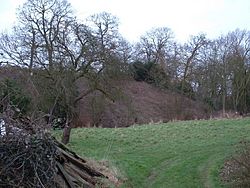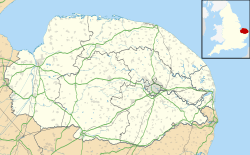Buckenham Castle facts for kids
Quick facts for kids Buckenham Castle |
|
|---|---|
| Old Buckenham and New Buckenham, Norfolk | |

Earthworks at New Buckenham
|
|
| Coordinates | 52°28′19″N 1°04′02″E / 52.471859°N 1.067253°E |
| Site information | |
| Condition | Earthworks survive |
Welcome to the story of two fascinating castles in Norfolk, England! These are Old Buckenham Castle and Buckenham Castle. They are located near the villages of Old Buckenham and New Buckenham. These historic sites tell tales of knights, kings, and ancient times.
Contents
Old Buckenham Castle: A Norman Beginning
Today, not much is left of Old Buckenham Castle. You can still see the mounds of earth that were once part of its defenses. There are also a few hints of its old stone walls. This castle was built a long time ago by William d'Aubigny. He was a loyal follower of William the Conqueror, who became King of England in 1066.
Later, the castle was moved to a new spot. A religious building called a priory (Old Buckenham Priory) was built on the old castle site. This construction unfortunately covered up many of the original castle remains.
Buckenham Castle: A Stronghold's Story
A new castle was built about two miles southeast of the old one. This happened early in the time of King Stephen. The same family, the Aubignys, built this new castle.
What Remains Today
If you visit today, you can see the foundations of a large round stone tower. This tower, called a keep, was about 60 feet wide. It is thought to be one of the earliest round keeps built in England. Its walls were incredibly thick, about 11 feet at the bottom! In its prime, the keep might have stood as tall as 40 feet.
Castle Defenses and Layout
Buckenham Castle had a strong inner area called a bailey. It also had two outer baileys. All these areas were protected by earth walls. Around the castle, there was a moat, which was a deep ditch often filled with water. There were also high earth banks called ramparts for defense.
A Castle Under Siege
This castle faced a tough challenge during the Barons' War in 1263. This was a time when powerful nobles fought against the king. The castle was attacked, or "besieged," during this conflict.
The Castle's End
Much later, in 1649, the castle was taken down. Sir Philip Knyvet, who owned it at the time, had it demolished. Only the moat and the earth ramparts were left behind.
The Knyvett Family and the Castle
The Knyvett family became important owners of Buckenham Castle. By 1465, Sir John Knyvet lived there. His daughter, Christiana, later married Sir Henry Colet. He became a very important person, the Lord Mayor of London.
New Buckenham Village
To support the castle and its soldiers, a new village was planned and built nearby. This village was called New Buckenham. Even today, the village looks much like its original plan. It has the same general layout.
Visiting the Site
Even though the castle ruins are next to New Buckenham village, most of the site is actually in the parish of Old Buckenham. This includes the castle ruins, the earthworks, and a chapel building. This historic site is very important. It is a Grade I Listed building and a Scheduled Monument. This means it is protected by law.
The castle grounds are private property. If you wish to visit, you can ask for access at the village shop on King Street in New Buckenham.


